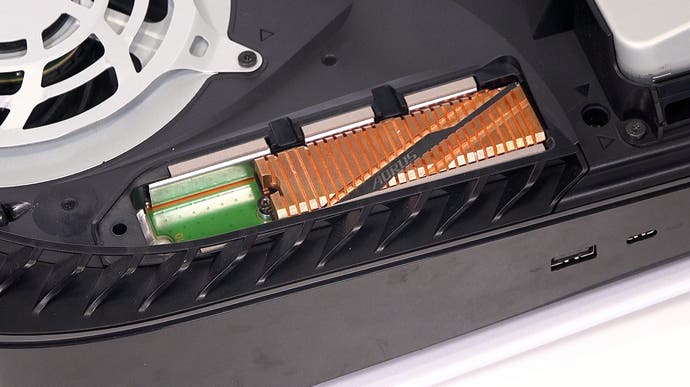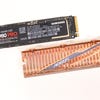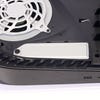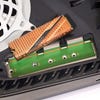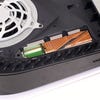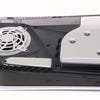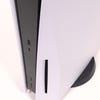PS5 Firmware Beta 2.0 tested: M.2 NVMe storage upgrades - can they match the stock drive?
Ratchet and Clank: Rift Apart analysis, plus extensive loading time tests.
PlayStation 5's next major firmware update is coming soon and it's set to deliver some key changes to the system's capabilities: a new UI that separates PS4 and PS5 apps, along with 3D audio for TV speakers - but the big draw is support for the PS5's internal M.2 SSD port, opening the door to a meaningful expansion of system storage, where we've been limited to just 667 gigs of usable space since launch. We've tested attachable USB storage solutions before and found them to be an excellent way to run PS4 titles under back-compat, but this is the real deal - this is the way forward for hosting more of our PS5 games on ultra high-speed storage.
Thanks to early access to the firmware courtesy of Sony - labelled beta 2.0-04.00.00 - we were able to complete some initial testing for this piece. We used a Samsung 980 Pro SSD - the 500GB model in this case, though these results should apply to large capacity 1TB and 2TB variants too. We actually bought this SSD when the PS5 launched specifically for this use-case as it met Mark Cerny's specs for NVMe drives laid out last year, and with 6500MB/s bandwidth, it exceeds Sony's spec of a 5500MB/s minimum. It's also a PCI Express Gen 4 model - another essential spec point. The only thing we needed to add was a heatsink, though you can run 'naked' if you like. We used a spare Gigabyte Auros heatsink we had to hand, but very cheap equivalents from Amazon are available that'll get the job done.
This is a fairly easy upgrade, but to be clear, it's a far cry from the plug and play Seagate Storage Card solution favoured by Microsoft for Xbox Series consoles. Even so, expanding PS5 storage shouldn't take more than 10 minutes. Step one is to pull away the PS5's white outer casing, specifically the right-side 'wing' when viewed head-on. The top two corners need a gentle pull upwards, and from there, you simply slide the casing down across the PS5's body. You'll hear a click.
Next, you open up the expansion bay. A small Phillips crosshead screwdriver does the job here, revealing the M.2 SSD enclosure. Once inside this, you'll need to remove the screw and spacer. Make note of the length of your chosen M.2 SSD, and plant the spacer at the relevant point in the bay. Installation of the SSD itself is a simple matter of sliding the heatsink-equipped SSD into the metal contacts at the bottom. Again, you'll hear a click. Place the SSD onto the spacer, tighten with the screw, reattach the expansion bay cover and then put the PS5 back together. Now we're good to go.
Booting the PS5 for the first time offers a quick setup. First, you format the SSD, and then you're greeted with a read speed test - the 980 Pro rated at 6500MB/s. Moving to the PS5's storage menu, there's some good news here as well. The M.2 SSD appears as it should here - but you can also use an external USB-based HDD alongside it. Add that to the PS5 internal drive and you have three drives to juggle data between in total - but remember you can only boot games from the internal drive or your freshly installed NVMe storage. Also useful is a new toggle to choose which SSD you want as your default install drive for games. Beyond that it's all very straightforward. The only glaring omission, as ever on PlayStation consoles to date, is the ability to copy games between drives. Right now, you can only transfer data in a cut-paste fashion.
The first test in putting our upgrade through its paces? Ratchet and Clank: Rift Apart - a game literally built around Sony's high bandwidth SSD solution. The rapid speed of PS5's internal drive gives birth to a new mechanic, letting Ratchet instantly travel between worlds using portals. Developer Insomniac makes a showcase of PS5's SSD tech from the first level: new assets stream in rapidly as Ratchet is taken on an on-rails tour of different planets. It flows beautifully on PS5's internal drive, though it's not faultless. Look close and you'll see streaming stutters as Ratchet careens through each portal, brief hiccups in the sequence that disrupt an otherwise tight lock in its performance RT mode. It's not a deal-breaker, but the chances are that if we're looking at a storage bottleneck, continuously switching between multiple worlds loaded on the fly is a likely candidate.
So to the comparison between the PS5 internal and our M.2 SSD. Testing each in our above video, performance looks to be essentially identical. In most cases it's actually an exact match between the two SSD solutions when it comes to the mentioned in-game stutter. Jumping portals triggers the same hitches, and always in the exact same moments - though with one instance where the M.2 is less severe in its drop that may be an outlier result. In all other respects, the 980 Pro performs in a similar manner to the existing storage solution, with equally flawless gameplay. As first impressions go, this is a strong start.
Loading times are up next. We split this into two banks of tests: PS4 titles running under backwards compatibility and true, PS5 native games. There's one thing to stress before we go on: for whatever reason, there can be a variance between loading times run to run, so there may be some outlier results. However, across all of our tests here, a trend is clear: using the Samsung 980 Pro in the expansion bay, loading times are generally better than they are on the internal drive and there seems to be an advantage in adding a heatsink to the NVMe SSD too, albeit slight. The exception to the rule is Battlefield 5, which consistently saw the internal SSD beat external options.
| PS4 App Loading Times (Seconds) | Stock Internal PS5 825GB | Samsung 980 Pro 500GB | Samsung 980 Pro 500GB/Heatsink |
|---|---|---|---|
| The Witcher 3: Novigrad Centre | 48.01 | 45.07 | 44.67 |
| The Witcher 3: White Orchard | 22.88 | 22.88 | 22.70 |
| Cyberpunk 2077: Ripperdoc | 41.12 | 43.93 | 38.48 |
| Cyberpunk 2077: Maelstromers HQ | 33.08 | 31.08 | 31.12 |
| Fallout 4: Commonwealth | 16.50 | 14.87 | 15.13 |
| Fallout 4: Diamond City | 15.27 | 14.01 | 14.17 |
| Final Fantasy 15: Lestallum | 29.18 | 27.43 | 27.60 |
| Final Fantasy 15: Hammerhead | 24.57 | 24.08 | 23.87 |
| Battlefield 5: Nordlys | 31.50 | 34.57 | 34.57 |
| Battlefield 5: Tirailleur | 31.58 | 34.63 | 34.53 |
The next set of tests concentrate on PlayStation 5 native apps - and in this regard, everything just works as we would hope and expect it to. Every test we carried out saw the external drive produce results that are near-identical to Sony's integrated custom SSD. There may be more variance in drives that barely meet the spec, while there are some PCIe Gen 4 drives that significantly fall south of Sony's bandwidth requirement. Not only that, but Sony says that even drives that meet the 5500MB/s bandwidth requirement may see degradation in game performance. We would strongly urge users to go with drives with 7000MB/s bandwidth all this considered, which was Mark Cerny's recommendation last year.
The only other takeaway we have concerns PlayStation 4 titles. Yes, the external M.2 option does generally seem to be faster than running from the native drive. However, we observed similar behaviour when PS4 games were loaded from SSDs attached via USB. If you're looking to optimise storage allocation, it may make sense to keep your PS5 titles on the internal drive and the NVMe expansion, but utilise a cheaper SATA to USB-based solution for PS4 games.
Regardless, here are the PS5 game loading test results - effective parity across the board. It may not by particularly interesting from a commentary perspective, but in terms of user expectations, it's exactly what we'd want to see. That said, further testing did throw up some unexpected results...
| PS5 App Loading Times (Seconds) | Stock Internal PS5 825GB | Samsung 980 Pro 500GB | Samsung 980 Pro 500GB/Heatsink |
|---|---|---|---|
| A Plague Tale Innocence: Mission 1 | 15.13 | 14.95 | 14.92 |
| A Plague Tale Innocence: Mission 2 | 16.92 | 16.48 | 16.53 |
| Star Wars Jedi Fallen Order: Kashyyyk | 16.43 | 16.43 | 16.45 |
| Star Wars Jedi Fallen Order: Bracca | 15.30 | 15.30 | 15.35 |
Our final tests were all about raw transfer speeds, where moving games between PS5's stock drive and the M.2 expansion is a perfect case study. Picking Cyberpunk 2077 gives us a meaty 101GB install to shuttle between these two drives. After extensive testing, it became clear that writing to the M.2 drive happens at a much more rapid pace than copying the same data back to the internal drive. For example, transferring Cyberpunk from PS5's internal SSD to the M.2 SSD takes just one minute and 11 seconds. That's an average rate of 1.42GB/s - an incredible speed given the sheer size of CDPR's game. Transfer speeds do vary according to content though, and so for example, copying Battlefield 5 from internal storage yielded a 0.87GB/s average transfer speed, while Final Fantasy 15 produced a 0.82GB/s average.
But if we transfer the game back, from the M.2 SSD to the PS5 stock drive, it takes far longer. The count comes in at seven minutes, 18 seconds - at a transfer rate of just 0.23GB/s. It's a huge difference, and one that bears out in transferring other big games - like Final Fantasy 15 and Battlefield 5. Transferring to the M.2 SSD will always be faster than it will be writing back to the internal drive, but generally speaking that is fine: a console SSD does not need tremendous write speeds. It's worth noting that while very slow, it's actually relatively fast when stacked up against copying back to the internal SSD via a USB-based option, as the table below reveals. Copying Battlefield 5 and FF15 back to internal storage delivered the same 0.23GB/s transfer rate average, suggesting some kind of system level cap.
| Cyberpunk 2077 (102GB) | Samsung 980 Pro Internal NVMe | Samsung 870 QVO SATA SSD (via USB) | Seagate 5TB Ext Hard Disk (via USB) |
|---|---|---|---|
| Copy from PS5 Storage | 1:11 | 6:15 | 16:24 |
| Copy to PS5 Storage | 7:18 | 13:37 | 16:26 |
The extra wrinkle to this is in how PS5's transfer speeds compare to Xbox Series X. It's worth stressing that repeat tests on Xbox gave a highly variable range of results. Even on rebooting the machine, or disconnecting from the internet, transfer times proved varied - something to bear in mind. Transferring Cyberpunk from Xbox's stock SSD to a Seagate expansion card, the best case puts average transfer speeds at 0.69GB/s, and at worst 0.42GB/s in transferring the exact same data. In all cases, it's much slower than the PS5 transfer test to its M.2 expansion. Meanwhile, the reverse journey on Series X - transferring Cyberpunk from its Seagate expansion card to its internal SSD - gives a transfer rate of 0.67GB/s at best and 0.55GB/s at worst. A mixed bag of results then: writing to the Seagate storage card was much slower than copying a game to the M2 drive on PS5. However, in copying the data back to the internal SSD, Xbox Series X was always significantly faster.
Ultimately though, firmware 2.0's storage expansion feature does exactly what it should and a crucial part of the hardware is finally unlocked, allowing users to add to the default 667GB storage of PS5's internal drive. And while this is a beta where the quality of delivery can change by the official release, results on our particular M.2 SSD are encouraging. The Samsung 980 Pro is fast enough to handle taxing PS5 exclusives like Ratchet and Clank and works just like PS5's stock drive in its delivery of high-bandwidth scenes. Plus, there's the loading time advantage. Most games in our test suite, from The Witcher 3 to Fallout 4, all run with a marginal lead on the 980 Pro. We have no loss in performance, and only a gain in overall storage. In terms of functionality, it's great to see external USB drives still work in conjunction with this M.2 SSD expansion. The only remaining bugbear, insofar as the PS5 front-end is concerned, is that we need a decent copy function for flexibility.
So, that's our first look at PS5 expandable NVMe storage for the M2 slot, but it's unlikely to be our last - we're interested in testing the best of the best and indeed the worst of the worst, not to mention the WD SN850 selected by Mark Cerny himself, based on this recent tweet which does seem to hit the sweet spot in terms of hardware specs, and comes with a heatsink attached out of the box. And if there are any other specific drives you'd like us to test - please let us know - but in the here and now, the news is good: PS5 may well be built around a custom solid-state storage solution, but a good PCIe Gen 4 SSD can match and in some scenarios actually exceed the performance of the internal solution, and works just as well on the most demanding storage-heavy game we've currently got to test.
